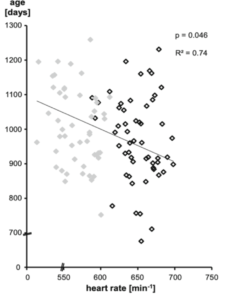The rate of living theory proposed by Max Rubner (1908) suggests that animals have a finite number of heartbeats till they die. The initial observation was that the large animals which have slower RHR (resting heart rate) live more than small animals which have faster RHR. Taylor (1980) explained this phenomenon with the “cost of generating force” hypothesis which suggests the amount of oxygen consumed by running animals is proportional to their weight. It was stated that producing one newton of force on the ground is more costly for smaller animals than for bigger ones because smaller animals must take shorter steps using faster, less economical muscle fibers than bigger animals do. Additionally, their larger area and volume ratio causes them to lose more heat. Therefore, small animals require more oxygen (per kg of body mass) to be delivered to the tissues in the body. However, the total number of heartbeats of most animals -large or small- tends to be approximately the same, around a billion, and humankind is stated as the exception with 2.24 billion heartbeats. Anyhow, if we consider it in terms of broad orders of magnitude, there does appear to be a tragic connection between living quickly and passing away soon for all species, large and small.


The mammalian heart is in charge of both pumping blood throughout the body and tuning the pumping activity in response to metabolic demands. Therefore, it was noted that the inverse relationship between life span and heart rate suggests that the heart rate is a marker of metabolic rate and RHR is commonly analyzed to estimate metabolic rate. It was suggested by Coburn et al. (1971) that a reduction in RHR could potentially increase lifespan. His team conducted a study where they fed mice with digoxin which slowed their heart rate down. According to their findings, treated mice with slower heart rates survived an average of 850 days, compared to 700 days for the control group. In a more recent study conducted by Gent et al. (2014), mice were treated with a drug called ivabradine which also slows down the heart rate. As a result, they reported that the lifespan of the treated mice was prolonged by 6.2%. Spindler et al. (2011), treated fruit flies with simvastatin (an arrhythmia drug with an RHR-reducing effect), and researchers stated that the drug dose-responsively increased the lifespan of fruit flies by 25%.
To conclude, the relationship between heart rate and life expectancy has been attributed to different metabolic rates in animals. According to several clinical studies, a low resting heart rate has been linked to health and an increase in life span. This led scientists to think about whether human life can be extended by slowing down the resting heart rate. However, other factors influence heart rate, and every one of these factors may have a separate impact on lifespan. Nevertheless, an increase in RHR has numerous proven adverse effects on the cardiovascular system because it increases the workload of the heart which results in problems such as arterial stiffness. Even though we do not have any certain evidence on lengthening our lifespan by lowering RHR, we now know that RHR is a critical indicator of overall human health therefore it potentially affects how long we live.
